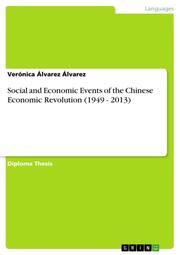Detailansicht
Social and Economic Events of the Chinese Economic Revolution (1949 - 2013)
ISBN/EAN: 9783668386129
Umbreit-Nr.: 1758971
Sprache:
Englisch
Umfang: 108 S., 1 farbige Illustr.
Format in cm: 0.8 x 21 x 14.8
Einband:
kartoniertes Buch
Erschienen am 27.01.2017
Auflage: 1/2017
€ 47,95
(inklusive MwSt.)
Lieferbar innerhalb 1 - 2 Wochen
- Zusatztext
- Diploma Thesis from the year 2013 in the subject Orientalism / Sinology - Chinese / China, grade: 10/10, language: English, abstract: The purpose of this thesis is to identify how the Chinese Economic Revolution has caused economic and social gaps between the poor and the rich. Nowadays, unfortunately, many Chinese still live in poverty, considering that China has overpopulation with 1.369811.000 citizens. The phenomenon of overpopulation has led to the creation of the One Child Policy, which has consequences: aging population, abortions; thus violation of human rights. There is the need to inquire deeply into the history of China, its beliefs, its dynasties, and its government. Thereby, it is easier to determine the main reasons and consequences of their economic revolution. The People's Republic of China or the "Middle Kingdom", founded in 1954, shows its Sino-centrism throughout its political, economic and social history. On the other hand, the Communist Party of China, with Xi Jinping as president, is the essence for the orientation of the interests of the Chinese, for the development of Chinas productivity, and for the starting point that the government uses to make national and international decisions. Mao Tse Tung and Deng Xiaoping were the promoters of the transformation of China. Mao Tse Tung based mainly on the socialist industrialization and socialist agricultural changes; however, those events were the reason of millions of deaths in China and the worst famine of the world. Deng Xiaoping followed the development process of Maoism, but he did it whit his own ideals, such as: application of economic reforms, trade liberalization, implementation of productivity factors. It helped to establish an economic model of investment, saving and exports in China. Nowadays, Chinas social development faces challenges to which economic and social policies will need to answer for. A main challenge is to fight for the high inequality in incomes, consumption; and access to education, health care, jobs and social protection. In addition, China not only needs to overcome the rapid aging of the population, but also, it needs to manage growing cultural, social and economic diversity to reduce the gap between the poor and the rich and decrease the current human rights violation.
